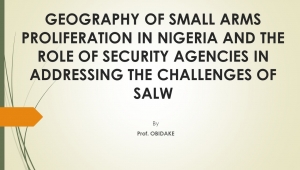
GEOGRAPHY OF SMALL ARMS PROLIFERATION IN NIGERIA AND THE ROLE OF SECURITY AGENCIES IN ADDRESSING THE CHALLENGES OF SALW
Small arms and light weapons proliferation is acclaimed to be the major security challenge to people, societies and states globally, fueling insurgency, human trafficking and drugs, terrorism, organized crimes, internal insurrections and civil
wars, posing obstacles to sustenance of stable peace and security. Many a times, little internal insurrection tends to escalate into larger civil wars and could destabilize a region (Kevin, 2007:23). This trend, especially in Nigeria is attributed to the weakness and fragile nature of the state and her attendant failure to deliver good governance. Small arms and light weapons are often employed to forcefully displace civilians, prevent development activities, humanitarian assistance, peace-building and peace-keeping endeavours in all sense. At the end of conflicts, small arms and light weapons usually remain in the society, which may cause more violence since crisis can resume or conflicts erupt in neighbouring regions. Also, in non-conflict environments, small arms may be used in criminal violence or may be used in suicides, accidents, homicides and others while they are sometimes the fundamental tools used by terrorists for societal annihilation (Holmes, 2014).
The role of geography within the study of conflict is increasingly popular, and “space” is taken seriously as an essential component of understanding conflict. Research areas in which spatial concepts have particular resonance include the location of conflict, the location(s) of violence within conflicts, diffusion and contagion patterns of violence, and as a context through which to understand the likelihood of violence. Geographers have contributed to this work and, separately, to a critical interpretation of conflict and peace that interrogates structures believed to create risk and vulnerability from local to global scales. However, there remains a serious divide between bodies of knowledge on geography and conflict but then, a concentration on studies within political geography can act as an effective bridge between these subjects.
But even more important is the fact that illicit smalls arms and light weapons are the conduits through which violence is prosecuted in a state’s territory. It goes without saying that arms are given mobility by individuals. The mobility is perpetrated through the smuggling of these arms through porous geography. Thus, when the political geography of a state is weak, it implies the porosity of borders and movement of illicit small arms and light weapons across a geographic area.
Be that as it may, the natural order in a state is for security agencies to respond to the prevalent threats caused by the proliferation of SALW. However, this responsibility has often been met enormous challenges especially in developing states like Nigeria where the security architecture of the state is poorly structured. Such challenges could stem from lack of technology, lack of proper training on the part of security personnel, failure in diplomacy and regional cooperation, etc.
This paper is thus an attempt to assess the geography of small arms and the critical measures undertaken by the security agencies to contain the threat posed by the proliferation.

